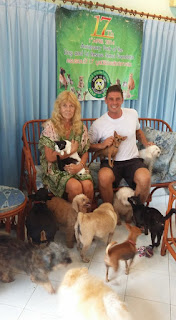Üble Zeiten oder? Terror vor unserer Haustür. Unmenschlichkeit allgegenwärtig. Wohin wird uns das führen? Was kann man dagegen tun?
Bjoern AFFA ® Official - Zurich 🇨🇭
instagram:bjoernaffa
http://www.bjoernaffa.ch
 Ich hab kein Allheilmittel aber ich weiss, dass diese Unmenschlichkeit schon bei Tieren anfängt und da kann jeder etwas tun... Ich versuch so oft wie es geht meiner kleinen 2-jährigen Nichte Kuscheltiere mitzubringen. Sie hat mittlerweile en kleinen Zoo zu Hause und wenn sie älter ist und mich fragt warum den echten Tieren soviel Leid widerfährt, dann werd ich nicht nur dasitzen und Sie traurig anschauen. Ich werde versuchen denen eine Stimme zu geben die keine haben. Ich werde Ihr erklären, dass es zu VIELE Menschen gibt die denken, dass Tiere keine Gefühle haben und sie deshalb schlecht behandeln.
Ich hab kein Allheilmittel aber ich weiss, dass diese Unmenschlichkeit schon bei Tieren anfängt und da kann jeder etwas tun... Ich versuch so oft wie es geht meiner kleinen 2-jährigen Nichte Kuscheltiere mitzubringen. Sie hat mittlerweile en kleinen Zoo zu Hause und wenn sie älter ist und mich fragt warum den echten Tieren soviel Leid widerfährt, dann werd ich nicht nur dasitzen und Sie traurig anschauen. Ich werde versuchen denen eine Stimme zu geben die keine haben. Ich werde Ihr erklären, dass es zu VIELE Menschen gibt die denken, dass Tiere keine Gefühle haben und sie deshalb schlecht behandeln.Ich sage Euch, Neid, Missgunst und Boshaftigkeit kennen Tiere in der Tat nicht, dass kennen nur wir Menschen. Aber sie wissen was Liebe ist, Treue und Loyalität. Du adoptierst einen Hund, gibst Ihm zu essen und er schenkt Dir seine bedingungslose Liebe, ohne Wenn und Aber.
Und jetzt sagt mir kennt ein Hund keine Treue & Loyalität? Wie kann man annehmen, dass ein Hund keine Gefühle hat wenn die meisten Menschen viel weniger Emotion in sich tragen als jedes Tier?
 Jeder soll sein Leben so leben wie er möchte aber wenn ich Facebook so durchschaue und die ganzen teuren Autos sehe, die schicken Klamotten, die Partybilder, exklusive Uhren, Bilder von Ferien in den teuersten Urlaubsregionen dann vermiss ich die Bilder mit denen man sich noch für etwas einsetzt.
Jeder soll sein Leben so leben wie er möchte aber wenn ich Facebook so durchschaue und die ganzen teuren Autos sehe, die schicken Klamotten, die Partybilder, exklusive Uhren, Bilder von Ferien in den teuersten Urlaubsregionen dann vermiss ich die Bilder mit denen man sich noch für etwas einsetzt.Damit SAMUI auch für SIe ein Paradies wird!
(nicht wie das AlibiSpenden auf zürcher strassen wo un-summen an firmen wie Corris Ag gehen)





















